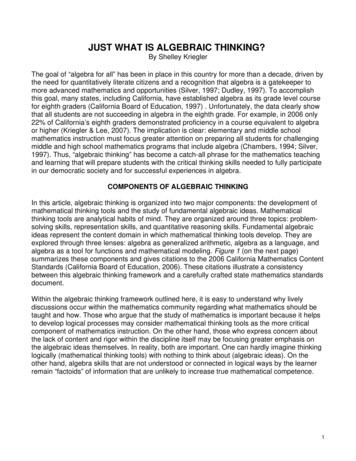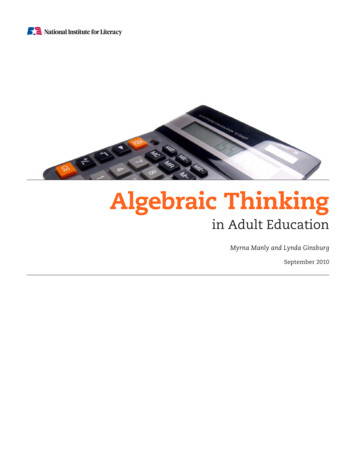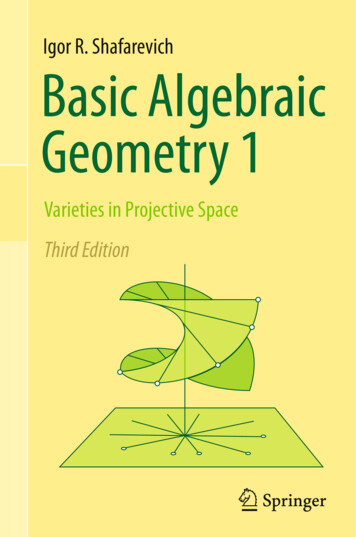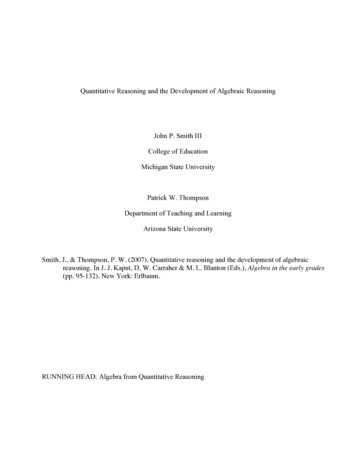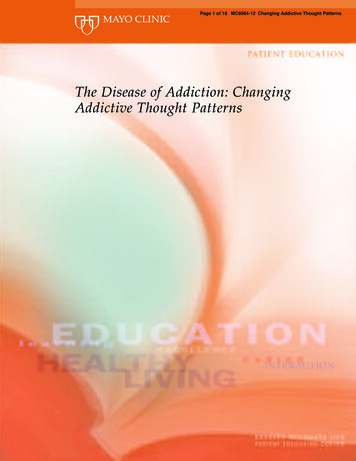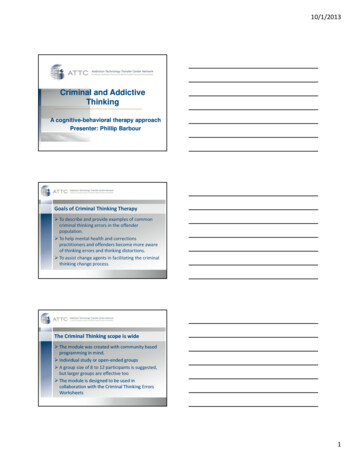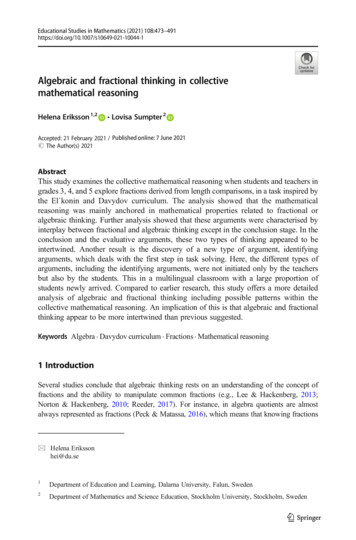
Transcription
Educational Studies in Mathematics (2021) 044-1Algebraic and fractional thinking in collectivemathematical reasoningHelena Eriksson 1,2& Lovisa Sumpter2Accepted: 21 February 2021 / Published online: 7 June 2021# The Author(s) 2021AbstractThis study examines the collective mathematical reasoning when students and teachers ingrades 3, 4, and 5 explore fractions derived from length comparisons, in a task inspired bythe El konin and Davydov curriculum. The analysis showed that the mathematicalreasoning was mainly anchored in mathematical properties related to fractional oralgebraic thinking. Further analysis showed that these arguments were characterised byinterplay between fractional and algebraic thinking except in the conclusion stage. In theconclusion and the evaluative arguments, these two types of thinking appeared to beintertwined. Another result is the discovery of a new type of argument, identifyingarguments, which deals with the first step in task solving. Here, the different types ofarguments, including the identifying arguments, were not initiated only by the teachersbut also by the students. This in a multilingual classroom with a large proportion ofstudents newly arrived. Compared to earlier research, this study offers a more detailedanalysis of algebraic and fractional thinking including possible patterns within thecollective mathematical reasoning. An implication of this is that algebraic and fractionalthinking appear to be more intertwined than previous suggested.Keywords Algebra . Davydov curriculum . Fractions . Mathematical reasoning1 IntroductionSeveral studies conclude that algebraic thinking rests on an understanding of the concept offractions and the ability to manipulate common fractions (e.g., Lee & Hackenberg, 2013;Norton & Hackenberg, 2010; Reeder, 2017). For instance, in algebra quotients are almostalways represented as fractions (Peck & Matassa, 2016), which means that knowing fractions* Helena Erikssonhei@du.se1Department of Education and Learning, Dalarna University, Falun, Sweden2Department of Mathematics and Science Education, Stockholm University, Stockholm, Sweden
474Eriksson H., Sumpter L.is essential if one is to learn algebra. Some researchers go even further and claim that studentsshould not be taught algebra before they can undertake general reasoning with fractions(DeWolf et al., 2015), or that algebra cannot be learnt until students understand structures inrational numbers, particularly the structures within fractions (Lee & Hackenberg, 2013; Norton& Hackenberg, 2010). In many school systems, this implies a late start of algebra as an area ofmathematical study.At the same time, a growing body of research concerning younger children’s mathematicalreasoning shows that children are capable of algebraic thinking, such as analysing relationsbetween quantities, performing generalisations, solving mathematical problems, and justifying,without formal education in fractions or rational numbers (Cai & Knuth, 2011; Carraher et al.,2006; Chimoni et al., 2018; Kieran, 2018). Some stress that algebra should be used to developproficiency, with an emphasis on arithmetic, instead of being treated as a distinct content areaapart from arithmetic and, in particular, that algebra should be used in measurements instead ofjust counting and operations to enhance number sense (Davydov, 2008; Izsák & Beckman,2019; Schmittau, 2011; Simon et al., 2018; Venenciano & Heck, 2016). This would require adifferent treatment of algebra and fractions.When looking at these two stances, it is unclear how algebraic thinking and fractionalthinking are linked independent of the stance. Also, the question if and how algebraic andfractional thinking interplay in mathematical reasoning, in the sense how different arguments interact with each other, has not gained much attention. In addition, researchersespousing both stances have identified a need for further research into algebra, especiallyregarding younger students (e.g., Carraher et al., 2006; Chimoni et al., 2018; Lee &Hackenberg, 2013; Norton & Hackenberg, 2010; Nunes et al., 2009). Therefore, there is agap in the research body, and the present study aims to address this gap by investigatingcollective mathematical reasoning in relation to algebra and fractions. The researchquestions are as follows: (1) What mathematical properties are arguments anchored inwhen students are analysing the fractional part of a mixed number? (2) What aspects ofalgebraic thinking and fractional thinking are these mathematical properties indicationsof? (3) In what way do algebraic and fractional thinking interplay in collective mathematical reasoning?2 BackgroundThree areas will be used as background to this study, namely, mathematical reasoning,fractional thinking, and algebraic thinking, with the last two having been treated in researchfor many years. Selected aspects of each research area that are central to the aim of this studywill be covered.2.1 Mathematical reasoningMathematical reasoning can be viewed in different ways (Jeannotte & Kieran, 2017; Sumpter,2013). Here, the starting point is to view mathematical reasoning as “[ ] the line of thoughtadopted to produce assertions and reach conclusions in task solving” (Lithner, 2008, p. 257),where we see the line of thought as a result of collective joint activity aiming at meaningmaking (Sumpter & Hedefalk, 2015, 2018). Compared to collaborative reasoning (e.g.,Granberg & Olsson, 2015), the emphasis is not on a specific individual or the characteristics
Algebraic and fractional thinking in collective mathematical reasoning475of reasoning such as different types of imitative reasoning. Here, the decisions and argumentsare created by a group of people where there is an emphasis on the collaboration (Sumpter,2016), and learning and teaching are seen as ongoing changes in human behaviour (Sumpter &Hedefalk, 2018). This allows us to focus on different arguments that are given for differentchoices made during the reasoning process, instead of, for instance, different processes withinreasoning or kinds of reasoning generated by different tasks (e.g., Jeannotte & Kieran, 2017;Lithner, 2008, 2017). However, compared to studies focusing on collective argumentation(e.g., Knipping, 2008), in order to have a more detailed analysis of arguments highlighting thedifferent mathematical properties, we follow Lithner’s (2008) notion of anchoring includingthe structure of reasoning.Hence, mathematical reasoning can be organised as a process that includes the followingfour steps (Lithner, 2008, 2017): (1) a (sub)task is explored (TS); (2) a strategy choice is made(SC); (3) the strategy is implemented (SI); and (4) a conclusion is suggested (C). For each ofthe last three steps, arguments can be connected to the choices made (Hedefalk & Sumpter,2017; Lithner, 2008). Analysing arguments and their mathematical properties is one way ofstudying mathematical reasoning (Lithner, 2008). Research has identified three types ofarguments (Hedefalk & Sumpter, 2017; Lithner, 2008; Sumpter & Hedefalk, 2018). Predictivearguments are linked to the strategy choice and are intended to answer the question “Why willthe strategy solve the task?”, while the strategy implementation can be supported by verifyingarguments asking “Why did the strategy solve the task?” (Lithner, 2008). A third type ofargument was discovered when analysing preschool children and teachers’ collective mathematical reasoning (Hedefalk & Sumpter, 2017; Sumpter & Hedefalk, 2018). It was then notedthat an argument can also be linked to the conclusion answering the question “How does theconclusion answer the question for the (sub)task explored?” These arguments are calledevaluative arguments. Arguments can be anchored in mathematical properties, which aredescribed as objects, transformations, and concepts (Lithner, 2008). Here, objects in relationto properties can be defined as numbers, variables, and functions. Transformations are what isdone to these objects, such as adding a fractional part to an integer. A concept is based on a setof objects, transformations, and their properties—that is, actions in relation to an object. In thisstudy, we are interested in properties related to fractional thinking and algebraic thinking.2.2 Fractional thinkingThere are several ways of describing fractional thinking (Lamon, 2012; Nunes et al., 2009). Inthis paper, we are interested in the mathematical content included in arguments, and the choiceis to use the fraction scheme framework presented by Steffe and Olive (2010). It has beenemployed in studies describing students’ understandings of fractions in different mathematicalsituations, such as written tests (e.g., Norton & Wilkins, 2009) and verbal arguments (e.g.,Boyce & Norton, 2016). Likewise, this framework uses a hierarchy and is often utilised todescribe a common progression in the development of understanding of fractions amongstudents (Boyce & Norton, 2016; Steffe & Olive, 2010). However, as these schemes alsodescribe students’ actions in relation to rational numbers (e.g., Norton & Wilkins, 2009), wechose not to concentrate on the progression including the hierarchy, but on the differentdescriptions of fractional thinking schemes presented in Table 1.The first fraction scheme is the part–whole scheme, which provides a way of producing andconceptualising any proper fraction, but not necessarily improper fractions (i.e., fractionsgreater than one). The second fraction scheme is described as the partitive unit fraction
476Eriksson H., Sumpter L.Table 1 Fractional thinking schemes according to Steffe and Olive (2010)SchemeActions(1) a part–whole fraction schemeUnitising proper fractions (smaller than one, but not necessarily improperfractions)Generating fraction languageUnitising an undivided whole as a proper fractionConceptualising, for example, three-fourths as three one-fourthsSplitting an unpartitioned piece of a larger whole to recreate the whole(2) a partitive unit fraction scheme(3) a partitive fraction scheme(4) a reversible partitive fractionscheme(5) an iterative rational schemeSplitting an unpartitioned piece of a smaller whole to recreate the wholescheme, in which students also generate fraction language. Also, compared with the part–whole scheme, the second scheme includes the division of a whole, even if this whole wasinitially undivided. This could be seen as a set of splitting actions (Confrey, 1994). Some of theactions included in this scheme are sharing, folding, dividing symmetrically, and magnifying.The third scheme is the partitive fraction scheme described as generalisation. This is whenstudents use a more general scheme to conceive of a proper fraction, for example, three-fourthsunderstood as three one-fourths of the whole. This scheme facilitates the development ofsplitting actions and of higher fraction schemes (Norton & Wilkins, 2009). The fourth schemeis the reversible partitive fraction scheme, which is the first scheme to rely on splittingoperations. For example, this scheme produces an implicit whole from a proper fractional partof the whole, such as the task of deciding how much of a given bar is 4/5 (Norton & Wilkins,2009). The fifth and final scheme is the iterative and reversible fraction scheme. In thisscheme, students can produce an implicit whole from any fraction, including improperfractions (i.e., m/n where m n). An example of this scheme is the task of drawing a bar thatis 4/3 of a given bar (Norton & Wilkins, 2009).2.3 Algebraic thinkingAlgebraic thinking can be broadly defined as a process by which students are analysingrelationships between quantities, noticing structures, studying changes, generalising, solvingproblems, modelling, justifying, proving, and predicting (Kieran, 2004). Similar descriptionstreat algebraic thinking as working with unknown numbers when analysing relations betweenand structures within numbers when these unknowns can be named or symbolised, even in anon-symbolic way (Radford, 2013), or as an arithmetic–algebraic work space (Hitt et al.,2016). Another suggested definition of algebraic thinking entails identifying four componentabilities (Blanton & Kaput, 2005): understanding patterns, relations, and functions;representing and analysing mathematical situations and structures using algebraic symbols;using mathematical models to represent and understand quantitative relationships; andanalysing changes in various contexts. What these descriptions share is a focus on actionsmore than mathematical properties, and although they could function as starting points, whenanalysing arguments in mathematical reasoning, further specification is needed.Therefore, the choice here is to use a description of algebraic thinking that also includesmathematical content, which allows us to explore and contrast different arguments rather thanjust describe a process. We follow Kaput’s (2008) description of algebraic reasoning, whichdefines two core aspects that cover a general description of algebraic thinking as “systematically symbolizing generalisations of regularities and constraints” (p.11) and “syntactically
Algebraic and fractional thinking in collective mathematical reasoning477guided reasoning and actions on generalisations expressed in conventional symbol systems”(p. 11). These two core aspects are then expressed in three strands. The first strand is called“the study of structures and systems abstracted from computations and relations, includingthose arising in arithmetic (algebra as generalised arithmetic) and quantitative reasoning”(Kaput, 2008, p. 11). This includes building generalisations of structures in arithmetic, whichcould be considered the primary route into algebra, for instance, building generalisations aboutparticular number properties or relationships (e.g., Bourbaki, 1974; Davydov, 2008; Radford,2013). It should be stressed that, in relation to emergent algebraic thinking, generalisations arenot necessarily explicit (Zazkis & Liljedahl, 2002). This strand includes computation strategies, conventional as well as student invited, and critical steps such as seeing the “ ” sign asequivalence instead of an operation in itself or as a separator of operations.The second strand concerns “the study of functions, relations, and joint variation” (Kaput,2008, p.11). This includes analytical aspects of the idea of functions but also includesgeneralisations of patterns, both number patterns and patterns of figures. One example of suchelementary patterning activities is the comparison of different expressions of a pattern todetermine whether they are equivalent. The patterns are thought to be necessary precursors toother forms of mathematical generalisations and different mathematical concepts with the aimof developing symbol sense (Blanton & Kaput, 2005). Here, we have objects, transformations,and concepts that could be viewed as more algebra specific, such as understanding in whatways two (physical) quantities are proportional to each other, as in measurement tasks from theDavydov curriculum (Davydov & Tsvetkovich, 1991). The second strand also includesconcepts from other mathematical areas, such as elements in a series (as in the above example),and variables, including transformations such as finding equivalent patterns and analysingfunctions, for instance, the use of “function machines” (Kaput, 2008).The third strand is about modelling (Kaput, 2008), of which there are three types. The firstis number- or quantity-specific modelling, in which a variable is regarded as unknown ratherthan as representing a situation. This means that we work on a specific case more than strivingto understand the representation of a class of situations. The second type of modelling isrelated to the first core aspect, meaning that the domain of generalisation of what is beingmodelled is emphasised and that variables are usually used. This could, for instance, be apattern expressed as a basic series or as a function. This type of modelling is also situationspecific. The third type of modelling involves further generalisations, including comparisonswith other models and situations; the expressions use variables, usually in the form ofparameters.Here we use these three frameworks to explore the collective mathematical reasoning whenstudents and a teacher are working on measurement tasks. The framework of collectivemathematical reasoning builds on mathematical arguments anchored in mathematical properties in objects, concepts, and transformations, and the two chosen frameworks regardingalgebraic and fraction thinking illuminate such mathematical properties.3 MethodsGiven our aim to investigate collective mathematical reasoning in relation to algebra andfractions, the task design becomes important. Since the El konin and Davydov mathematicalcurriculum was created to use algebra as a tool in joint activities focusing on students’ agencyto develop knowledge about numbers (Davydov, 2008), we decided to use it as a stimulus to
478Eriksson H., Sumpter L.generate arguments about fractions and algebra. These lessons happened once a week. Theempirical data for the present study came from three lessons in two collaborative projects, bothwith the purpose of exploring this particular curriculum (H. Eriksson, 2015; Eriksson &Eriksson, 2016). The lessons were designed by the participating teachers (n 7) and the firstauthor in an iterative process following a learning study set up, of which the lessons in focusare number five in the process (Eriksson, 2015). The lessons were taught by the ordinary classteachers and video recorded by the first author.3.1 Task designThe tasks were inspired by Davydov and Tsvetkovich (1991) and build on the idea ofmeasurement in which fractions are viewed as the results of comparisons that do not representequality (Davydov, 2008). All tasks were formulated as “measure one length with anotherlength,” with the aim to generate fractional thinking using algebra as a tool. Cuisenaire rodswere used in comparing lengths in these lessons, which represented different degrees ofdifficulty. The specific tasks were chosen based on previous lessons in which the studentswere constructing measurement on their own choosing which rods to measure and choosingthe different units of measures. Therefore, depending on what measurements the studentsfound problematic, the following tasks were chosen: the measurement in grade 3 was tocompare the black rod with green rods, grade 4 to compare the black rod with red rods, andgrade 5 to compare the blue rod with yellow rods (see Fig. 1).The core of each task was to identify the fractional part of the unit of measure. In the lessondesign, the students first had to identify a length to be measured (the black and blue rods), theunits of measure (the green, red, and yellow rods), and the fractional part of the unit of measure(i.e., the smaller unit of measure, here represented by the white rods). Given that the black andblue rods are both variables (i.e., lengths) treated as unknown, the task itself is within the thirdstrand of algebraic thinking, i.e., modelling (e.g., Kaput, 2008). In the series of lessons, theteachers followed a design suggested by Davydov (2008) based on analysing relationshipsamong quantities grounded in measurements. Therefore, in all three tasks, the first step was tofind inequalities. The second step is to construct equality using a remainder, and the third stepis to explore the remainder. Here, W stands for the whole (i.e., the unit of measure, hence alength that varies) a notation chosen by the teachers, and r stands for the remainder, whichdepends on W (Fig. 2). In the remainder, m stands for the numerator and n for the denominator,Fig. 1 The three sets of rods used,left to right: black and green, blackand red, and blue and yellow.White rods are the smaller unit ofmeasurement
Algebraic and fractional thinking in collective mathematical reasoning479Fig. 2 The notations used in theanalyses for this papernmr aWWwhere m and n are lengths in s, the smaller unit of measure. In this sense, the task is a system ofequations. The following notation is used for the equations:8ð1Þ aW Black or Blue ða þ 1ÞWBlack or Blue ¼ aW þ rWð2Þ : r ¼ m s; where W ¼ ns; a; m; n ℤ þ ð3ÞnIn the previous lesson, the students had worked with measurements, in which the object to bemeasured was a whole number of the unit of measure; it also included problems in which thelengths to be compared were not equal, meaning that the task and some of the notations, suchas W, were not completely new.3.2 Data collectionThe data consist of transcribed videotapes capturing collective mathematical reasoning from threelessons, each lasting an entire class session, one from each of grades 3, 4, and 5. The primaryschool had a high proportion of newly arrived (to Sweden) students; approximately twenty totwenty-five native languages are spoken at the school. This meant considerable variation in theages of the students: the grade 3 lesson involved 22 students of 8–10 years old, the grade 4 lessoninvolved 20 students of 9–11 years old, and the grade 5 lesson involved 25 students of 9–13 yearsold. All the students and their parents signed letters of consent allowing the students to participatein the project. The agreement covered the video documentation of the research lessons andpermission to use the video recordings and other material, such as the students’ worksheets, inresearch. This letter was translated orally for parents who did not read Swedish. Other ethicalconsiderations stipulated by the Swedish Research Council (Vetenskapsrådet, 2017) werefollowed, including keeping the informants’ identities anonymous.3.3 Method of analysisThe data were transcribed, and the students were assigned fictive names in the transcripts. Apreliminary analysis found no differences between the three lessons in terms of the mathematicalreasoning, here referring to the main line of thought regarding strategy choice and implementation.The three lessons are therefore treated in the same way in the analysis. In total, 160 min of data weregenerated from these three lessons. The transcripts reported the students’ and teachers’ actions,
480Eriksson H., Sumpter L.including gestures and oral and written communication. Given that so many students had differentfirst languages and that many of them were newly arrived, the teachers used repetition to supportlanguage development. These repeated passages, and others judged irrelevant to the purpose of thispaper, such as talk about discipline, were marked as “[ ]” and not included in the analysis.The data were analysed in five steps. The transcripts were organised using Lithner’s (2008)reasoning structure, and the first step was to detect episodes in each lesson that addressed theproblem in focus. The second step was to identify the task situations (TS), strategy choices(SC), strategy implementations (SI), and conclusions (C) that followed in these episodes. Notethat it is possible to expand or reduce the task situations to include more or less information, soan appropriate granularity was chosen for the analysis of each episode. As a third step of theanalysis, we identified predictive or verifying arguments connected to the SC and SI (Lithner,2008), or evaluative arguments found in the conclusion (Hedefalk & Sumpter, 2017).In the fourth step, the mathematical properties of the components anchoring the differentarguments were identified and analysed. Here, the focus was on fractional thinking andalgebraic thinking and the possible interplay between the two. Regarding fractional thinking,we used the fraction scheme framework (Norton & Wilkins, 2009; Steffe & Olive, 2010).Given the nature of the tasks, only the first two schemes are relevant to this study, the part–whole fraction scheme and the partitive unit fraction scheme, both connected to the mathematical idea of splitting the whole (Confrey, 1994). The part–whole scheme can be illustratedby arguments made when the whole is already divided into parts, while the partitive unitfraction scheme can be illustrated when the whole is being split by the children. Someexamples of mathematical properties considered indications of fractional thinking were objectssuch as remainders, concepts such as rational numbers, and transformations such as division.In categorising algebraic thinking, the three strands of the two core aspects of algebra consideredalgebraic reasoning by Kaput (2008) gave us tools both for highlighting overarching processessuch as generalisation and for talking about, for instance, different aspects of modelling. Note thatwe apply the idea of emergent algebraic thinking (e.g., Radford, 2013; Zazkis & Liljedahl, 2002),meaning that talk and actions that could be seen as first steps to a generalised idea will beinterpreted as such. Some of the mathematical properties considered algebraic thinking concernedstructures such as mathematical objects and transformations, which are included in mixed numbers,and relations such as mathematical concepts and transformations, which are involved in thedevelopment of equalities. As the last step, to explore whether algebraic and fractional thinkingmight overlap, we compared the different steps of the reasoning (i.e., TS, SC, SI, and C). In thesecomparisons, we identified arguments that include properties categorised as both fractionalthinking using fraction schemes and algebraic thinking seen as algebraic reasoning.Table 2 Analytical structures and the unit of analysisReasoning Mathematical propertiesFraction schemesAlgebraic reasoning
Algebraic and fractional thinking in collective mathematical reasoning481In this way, Lithner’s (2008) framework provided a structure for ordering the data and,together with the theoretical tool of Hedefalk and Sumpter (2017), for identifying different typesof arguments. The unit of analysis is the content of these arguments, the different mathematicalproperties. These are compared with the fraction schemes (Steffe & Olive, 2010) and the coreaspects and strands presented in the algebraic reasoning framework (Kaput, 2008); see Table 2.4 ResultsThe task situations chosen to illustrate the results come from grade 4, thus the measurement ofthe black rod with the red rod as a unit of measure (Fig. 1). Similar reasoning, here referring tothe particular mathematical properties in focus, was evident in grades 3 and 5 as well. The mainreasoning evident in the data is algebraic thinking, such as modelling, and fractional thinking,such as dividing a whole, and the focus is on specific arguments. In each task situation, W is afixed length and is therefore not denoted as a variable, whereas r is treated as a variabledepending on the students’ choice of a smaller unit of measure. The teacher is noted as “T”.Tables including the Swedish language of the students is presented in Tables 7, 8, and 9.4.1 The task situation 1 and 24.1.1 The first task situationThe first task situation was about identifying inequality (equation 1). When this situation starts,the students and the teacher have just begun to measure the black rod using the red rods (seeTable 3). The task was chosen since some of students had worked with it the day before, buthad struggled to construct a solution. In this first section, the teacher reformulates the problemto a new task situation, presenting a new model.In the first task situation, the focus is on trying to understand the inequality where the redrods are longer than the black rod, which is a study of structure. The reasoning ends at 01:55when the teacher redirects the students to a new task situation and asks for arguments aboutthis new problem, to identify the central mathematical properties of the task. One can see thisquestion as a stimulus for a new type of argument not explored before, namely, identifyingarguments. Chaid stresses the remainder in the inequality, which is a part of the study ofstructure. After some guessing out loud, where the students are using fraction language(second fraction scheme) and the teacher is quiet, Bayar takes command of the reasoning byconfirming an earlier guess of 3½. Two inequalities are constructed through the division of thewhole into parts that could be interpreted as the second fraction scheme. There is also asuggestion of how to construct equality using r, “a little bit more”. As a study of inequalitystriving for equality, this could be seen both as a study of structures and as emergentmodelling.
482Eriksson H., Sumpter L.Table 3 Grade 4: identifying inequality, equation 1Timecode [The students are entering theclassroom and the teacher isdrawing a line segment on theboard. On the board is themeasure seen here.]T: Some of you constructed thismeasure yesterday. You decidedto measure a black rod with redrods only.Students together: It didn t work.T: But was it just to measure?How did it work? Does anyoneremember the difficulty? Whatis our problem? [The teacher ispointing at the measurement onthe board.]Dana: It is too much. It is longer.T: What’s the problem? What didshe say?Adam: She said we could measurethe red rods with the black one.Mathew: Take other colours.T: That's another task. Interesting.We can do that another time.What's our problem right now?[The teacher takes the last unit, thelast red rod away.]Analysis of ArgumentsIdentification ofmathematical propertiesTS: Estabishing TS. SC tomeasure.TS is study of structure.SC is dividing a whole inparts.Confirming TST asking for verifying argumentsabout the SI.C: evaluative arguments provided. Inequality is notedBlack rod (a 1)WT asks for identifying arguments.SC: suggestion to measure red rodswith black rod, SC not accepted.SC: sugge
using mathematical models to represent and understand quantitative relationships; and analysing changes in various contexts. What these descriptions share is a focus on actions more than mathematical properties, and although they could function as starting points, when analysing arguments in mathemat
